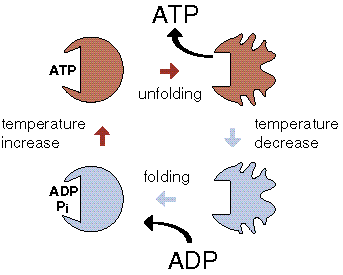
|
Protein associated thermosynthesis: PTS |
Introduction
Some websites on ATP synthase:
Antony Croft at the University of Illinois at Urbana,
on bioenergetics,
on ATP Synthase
Joyce Diwan at Rensselaer University
Wang and Oster at the University of California, Berkeley
Rod Capaldi at the University of Oregon
F1ATPsynthase
Almost all of the energy used by organisms comes from ATP, which in animals is synthesized in specialized cell organelles called mitochondria. These contain the ATPsynthase enzyme, or, more specifically, the enzyme FoF1ATPsynthase: the composite enzyme consists of the Fo and F1 moieties. In the latter, ATP is formed from ADP and phosphate. When ADP, phosphate, and ATP are dissolved in water, ATP has the higher free energy. During dry conditions, however, there is not much difference in free energy between ATP and (ADP plus phosphate). According to the binding change mechanism [Boye79, 84, 93] F1 binds ADP and phosphate. When bound the ADP and phosphate react to form ATP; in the local absence of water this process does not cost free energy. The formed ATP is however strongly bound; it cannot spontaneously be released from the F1 unit, as this would result in a free energy gain. F1 can only release the bound ATP after Fo does work on it, and Fo obtains this work from the protons falling across the electrical potential difference across the membrane.
The proposed pF1
The protein-associated thermosynthesis mechanism (PTS) assumes that a progenitor of contemporary F1, called pF1 had the ability to release strongly bound ATP formed from ADP and phosphate during a thermal unfolding of the enzyme [ Mull95]. During a thermal cycle the pF1 thus functions as a heat engine. All pF1 does is form a small, dehydrated pocket that binds ADP and phosphate, letting these substrates react, and release the ATP product. A more simple enzyme is hard to imagine; regular enzymes are even more complex. They function isothermally, and have to bind their substrates, which lowers the free energy, while they have to accelerate a chemical reaction, which involves an increase in free energy: activation energy is required. So pF1 is relatively simple, as no activation energy has to be obtained.A catalyst that has a requirement for a thermal cycle or cycling is called a thermozyme.

Discussion
The next page gives the details of a second mechanism for thermosynthesis, a mechanism that makes use of biomembrane: The Origin of Life by Thermosynthesis.
Copyright © 1999-2005 Anthonie W.J. Muller